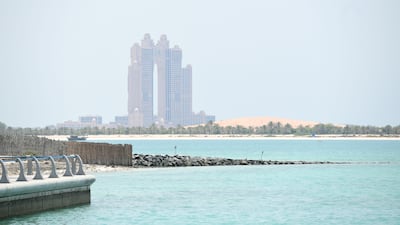Temperatures in the UAE have been at the upper end of the thermometers all summer.
Outdoor terraces are closed and the balconies are still off limits due to the high levels of heat and humidity.
Historically during August, the average maximum relative humidity in the UAE is 72 per cent, with fog and mist forming a number of times throughout the month, according to the National Centre of Meteorology.
The most foggy August was recorded in 2018, when the UAE experienced 15 days of foggy weather in just one month.
Dubai and Abu Dhabi typically get two blasts of high humidity, in June and September – dubbed 'Sweat-tember' by residents.
High humidity makes the hot days ever warmer. So what is the science behind the weather that causes so many sweaty work shirts? And is the way we commonly measure humidity wrong?
Humidity explained
Humidity comes from water evaporating from large bodies of water. As temperatures heat up, so do the seas, for example, causing more moisture to evaporate into the atmosphere. This is why humidity is worse in coastal areas – such as Abu Dhabi city and Dubai.
Humidity is measured by how much water vapour is in the air around us. The more moisture in the air, the higher the humidity.
Usually, the humidity figure on weather forecasts is relative humidity, or the moisture in the air as a percentage of the maximum amount of water vapour the air can hold. How much moisture the air can hold depends on the air temperature.
Why is humidity so uncomfortable?
It might be 38°C on both Monday and Tuesday, but Tuesday might feel far hotter. The reason is likely to be humidity, and more specifically, how our bodies react to it.
We tend to deal with high temperatures with low humidity relatively well. When it is hot but there is low humidity, we sweat and this moisture easily evaporates into the atmosphere. This process helps us to cool down.

However, in very high humidity, the atmosphere is already heavy with moisture, meaning it is so clogged up, there isn’t room for much more vapour. This means fluid from our skin evaporates more slowly, causing our bodies to overheat.
This is why there are often two numbers in weather forecasts – the actual temperature, and a “feels like” figure, which is supposed to take humidity into account.
How can we cope?
At times of high humidity, it is especially important to stay hydrated. When possible, avoid going outside, and those who exercise outdoors should be particularly aware of the potential dangers of heatstroke. At home, a dehumidifier can help by sucking moisture out of the air.
What about the dew point?
Meteorologists often use the dew point as a measure of how much water vapour is in the atmosphere, and many argue this gives a far more accurate prediction of how uncomfortable humans are likely to feel, compared with relative humidity.
Crucially, warmer air can hold far more moisture than cooler air.
The dew point is the temperature at which dew begins to form on things such as grass or condenses into mist or fog.
In other words, it is the point at which air can no longer hold all of the vapour and some is condensed into liquid, meaning relative humidity is 100 per cent.
The dew point is always lower or equal to the air temperature. The closer the air temperature is to the dew point, the more humid it will feel. And if they are further away, it will feel comfortable.
Critics of the relative humidity measure argue that while simple, it is often misleading. This is because the amount of moisture the air can hold varies according to the temperature. So, while relative humidity tells us how close the water in the air is to saturation, it does not tell us how much total moisture is actually in the air.
For example, 70 per cent relative humidity may sound high, but if the weather is cold, this would feel less stuffy than 50 per cent relative humidity in very hot weather, because a higher quantity of actual moisture would be in the air.
What other problems can humidity cause?
It is not just feeling uncomfortable. Humidity is often blamed for mould, as water from the air settles on surfaces. It can also affect electronics or contribute to the formation of hurricanes and cyclones.
Is it getting worse?
Research has suggested that global warming may lead to heatwaves beyond the limit of human survival, such as in places such as Abu Dhabi and Dubai.
A study published in 2015 said wet bulb temperature – a combined measure of heat and humidity – is set to increase if global carbon emissions continue at current rates.
At a WBT of more than 35°C, even the fittest person would find it impossible to cool their body naturally by sweating, meaning humans could potentially die within the space of six hours.
Scientists have predicted that such extremes could occur every decade or two – after 2070 – along much of the coast of the Gulf, if global warming is not curbed.
A version of this story was first published July 5, 2023








